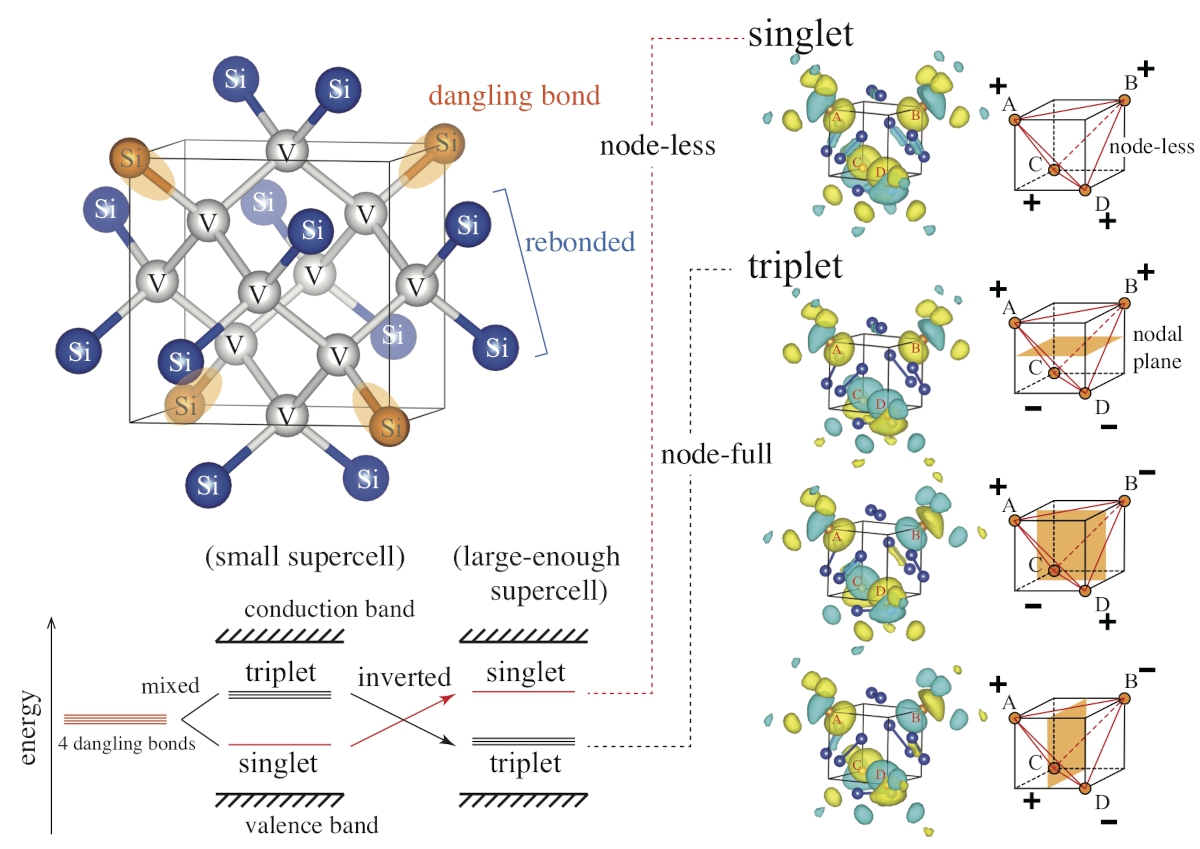Can a Node-Less Wave Function Have Higher Energy than Node-Full Ones?
© The Physical Society of Japan
This article is on
Discovery of Peculiar Electronic Structures of Decavacancy V10 in Silicon Crystal
(JPSJ Editors' Choice)
J. Phys. Soc. Jpn.
91,
064709
(2022)
.
“The energy level of an electron state increases as the number of nodes in its wave function increases.” The preceding statement, often found in textbooks, was challenged by our large-scale DFT (density-functional theory) calculations performed for the decavacancy in Si crystal.

In quantum mechanics textbooks, a node-less wave function is described as having lower energy than that with nodal planes, because the kinetic energy increases with an increasing number of nodes. This statement has been thought to be universal.
However, we have recently found an exceptional case in the decavacancy of Si crystal, where node-less mixing of four dangling-bond orbitals (φA, φB, φC, and φD) in the singlet state leads to a higher energy than node-full mixing in the triplet states. That is,
where
Ψsinglet  (+φA+φB+φC+φD)/2,
(+φA+φB+φC+φD)/2,
Ψtriplet  (+φA+φB -φC -φD)/2,
(+φA+φB -φC -φD)/2,
(+φA -φB -φC +φD)/2,
(+φA-φB +φC -φD)/2.
This unexpected energy ordering is the enigma discussed and solved in our study.
Decavacancy V10. is one of the magic number vacancies, obtained by removing a Si10 cluster from an otherwise perfect Si crystal. Although the vacancy is accompanied by 16 dangling bonds, 12 of them are re-bonded with adjacent ones. Thus, we have only four dangling bonds remaining in V10. The four dangling-bond orbitals (φA, φB, φC, and φD) are arranged under the Td symmetry, which mix to generate the singlet and triplet electron states in the band gap, as described by Eq. (2). Our finding in Eq. (1) is surprising, because it seems to contradict a universal rule stated in the textbooks.
To clarify the underlying physics, we constructed a model to reproduce the energy ordering in Eq. (1), and successfully showed that such a non-intuitive electronic structure originates from the slight hybridization of the four dangling-bond states in the band gap with the 12 re-bond states outside the band gap. Here, the “re-bond states” refers to the six bonding states in the valence band and the six anti-bonding states in the conduction band, generated when 12 dangling bonds are paired with adjacent ones. Although such pairing makes the rebond states inactive, we found that the passivation was not perfect. They are slightly hybridized with the four dangling-bond states in the band gap, which make the energy of the node-less singlet higher than that of the node-full triplet.
We argue that this peculiar electronic structure is reflected in the Jahn-Teller instability of the system. We also note that large-scale DFT calculations are paramount for this work, because the supercell size must be large enough for the results of calculations to converge into Eq. (1).
(Written by K. Uchida on behalf of all authors.)
Discovery of Peculiar Electronic Structures of Decavacancy V10 in Silicon Crystal
(JPSJ Editors' Choice)
J. Phys. Soc. Jpn.
91,
064709
(2022)
.
Share this topic
Fields
Related Articles
-
Exploring the Vibrant Interplay of Machine Learning and Physics
Cross-disciplinary physics and related areas of science and technology
Electron states in condensed matter
Elementary particles, fields, and strings
Mathematical methods, classical and quantum physics, relativity, gravitation, numerical simulation, computational modeling
Statistical physics and thermodynamics
Superconductivity
2025-3-13
This Journal of the Physical Society of Japan Special Topics edition explores how physics and machine learning complement each other and can solve unresolved problems in physics.
-
Excitonic Insulators: Challenges in Realizing a Theoretically Predicted State of Matter
Electron states in condensed matter
Electronic transport in condensed matter
2025-3-3
The realization of an excitonic insulator can help in the establishment of a new electronic state in condensed matter physics, one that has the potential to exhibit novel electric, magnetic, and optical responses beyond those of conventional materials.
-
Bayesian Insights into X-ray Laue Oscillations: Quantitative Surface Roughness and Noise Modeling
Measurement, instrumentation, and techniques
Structure and mechanical and thermal properties in condensed matter
2025-2-14
This study adopts Bayesian inference using the replica exchange Monte Carlo method to accurately estimate thin-film properties from X-ray Laue oscillation data, enabling quantitative analysis and appropriate noise modeling.
-
Hyperuniform and Multifractal States in Bosonic Quasicrystalline Systems
Statistical physics and thermodynamics
Structure and mechanical and thermal properties in condensed matter
2025-2-10
Quantum states can be categorized as hyperuniform or multifractal based on electronic characteristics. This study demonstrates that bosonic quasicrystalline systems exhibit hyperuniform or multifractal quantum states.
-
Spin-Spin Interaction Mediated by Rotational Lattice Vibrations
Magnetic properties in condensed matter
Structure and mechanical and thermal properties in condensed matter
2025-1-24
This study predicts the presence of spin-spin interactions mediated by the angular momentum of lattice vibrations, which can be long-range.




